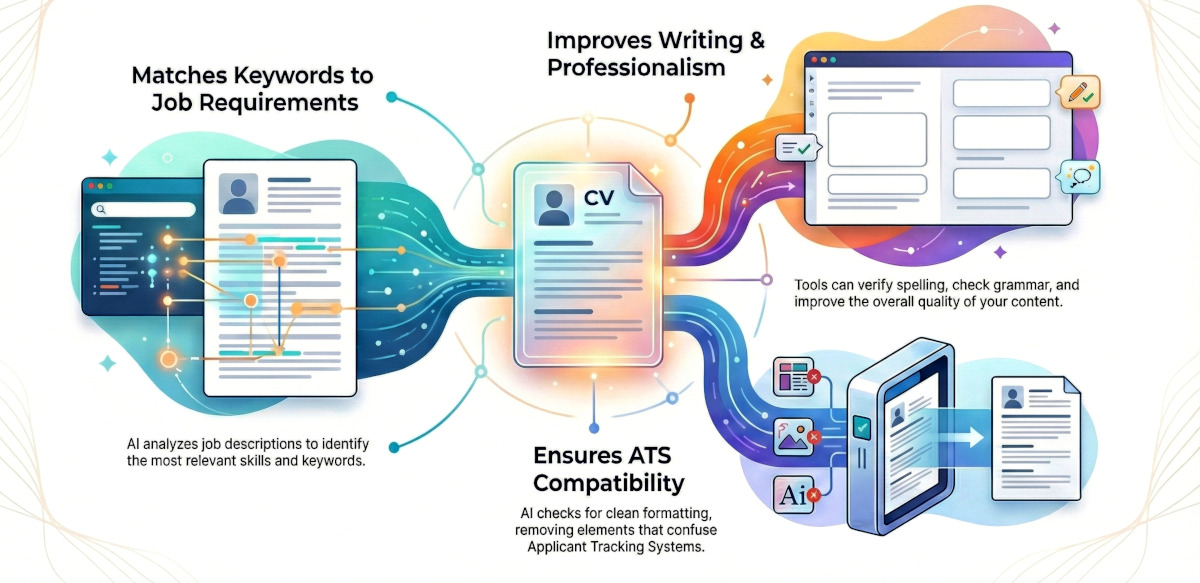- 1. How to Write a CV: Complete Guide for 2025 (Design Tips & Examples)
- 5. What exactly is a CV, Curriculum Vitae?
- 11. CV writing – Crafting the CV sections
- 16. CV writing: Customise to match the job requirements
- 21. Additional tips – CV design tips
- 24. AI evolution and CV writing in 2025
- 26. Conclusion
- 27. FAQ
This CV writing guide can help you keep up with today’s demanding job market and present your professional skills and value in the most impactful way possible. It’s a comprehensive guide that walks you through the process of creating a CV, so you can learn how to write an effective CV. Whether you’re writing your first CV or updating an existing one, you’ll find useful tips and real examples to improve your job applications.
Also, the guide contains customisation advice and suggestions for CV formatting and the use of AI tools to improve job matching. The CV writing guide explains how to write personalised CV sections, the differences between CVs and resumes, and how to write career summaries or profiles.
How to Write a CV: Complete Guide for 2025 (Design Tips & Examples)
Today’s global landscape is navigating towards remote and hybrid work models while leveraging technology to find talent. This shift requires a new mindset to help you shape your CV writing to pinpoint your competence and worth.
In this new context, the CV design and content become a strategic marketing document. Its role is to help you pass the Applicant Tracking System (ATS)—software that scans for keywords, and also to impress the recruiter or hiring manager who might only give it a six-second glance.
This guide also includes several tips on CV writing, focusing on showcasing critical skills and quantifiable achievements that match the job description requirements. You will understand how to use an AI tool to improve your CV, analyse a job description to identify matching keywords to transform responsibilities into data-driven accomplishments and quantifiable achievements.
Why do CV writing skills matter?
Creating an effective CV involves synthesising relevant information while clearly communicating the value and impact of your professional achievements. Demonstrating the tangible value of your professional contributions involves analysing career paths, work responsibilities and highlighting relevant qualifications and skills.
Along any career path, CV writing skills are lifelong skills that need constant improvement because work experiences and interests inevitably evolve over the years. An updated, well-crafted CV is vital for positioning yourself effectively in today’s competitive job market.
Focus on achievements and skills
Nowadays, fast-paced working environments and skills-based hiring have changed the CVs into shorter and customised documents. CVs focus on achievements and skills, and less on responsibilities or duties. Also, social profiles and online presence have gained more importance over time.
Past roles are significant for career growth and reviewing your long-term professional goals. Also, connecting revising and adapting past experiences might reveal new learning and development opportunities. Enhancing your CV increases your ability to pursue new professional opportunities or advance in your career.
There is a great emphasis on quantifiable professional accomplishments, tech skills and personal attributes, reflecting socio-cultural influences on the workplaces. Your profile must help you demonstrate that you possess the key skills, work experiences and abilities employers need.
Keeping your CV up to date
Updating CVs, profiles, or resumes keeps you relevant in the market and highlights your strengths rather than limitations. The CV is a marketing tool that not only documents professional history but also needs to keep up with new recruitment practices.
Updating your CV is vital due to constant market changes, remote work and globalisation. These social and economic changes have recently influenced CV writing, format and content. Highlighting remote work experience and using specific industry keywords and skills to show your competence in this globally connected world is now a must.
What exactly is a CV, Curriculum Vitae?
Over the years, the Curriculum Vitae (CV) has changed significantly regarding content, purpose, and writing styles. These changes reflect technological advancements, social changes, shifts in organisational cultures, and recruitment trends.
Traditionally, the CV is an extensive document that comprises a candidate’s education, work experience, qualifications, skills, abilities, and professional achievements in the “course of life”, Latin for Curriculum Vitae.
CV’s purpose was to list all responsibilities, education, qualifications, and abilities and to present a detailed and documented view of professional background, and it’s a formal record based on which employers documented candidates’ competencies for their available roles and their hiring decisions.
CV Types: How to Choose the Right CV Format
Nowadays, the traditional long-form CVs are mainly required in academic, research or governmental institutions. For some official European organisations, public institutions, and certain European banks, the Europass CV template is mandatory. Other public organisations or research and development institutions have their own application forms to fill in.
The chronological CV
In the chronological CV, the history of work experiences is in reverse chronological order, starting with your most recent position listed first. It’s suitable for experienced candidates with an observable professional evolution or career path. Because it uses the reverse chronological order of employment history, it’s favoured by ATS and recruiters.
The functional CV
The functional CV emphasises skills and abilities rather than work history. Its main focus is on showcasing qualifications, education and skills faster. This type of CV provides a strategic way to present qualifications when a chronological employment history might not tell your best story.
The functional CV has its origins in the career transition needs of the 1970s. It’s structured around the most important skills and experiences candidates have for the job you are applying for. Also, if the current or past work experience has been in an unrelated role, this is a more flexible form to choose.
What is the best CV format, a chronological or functional CV?
Depending on your professional experiences and background, you can choose between a chronological or functional CV. These are the main CV types, but you can combine both of these types if you think this favours your job application.
This format’s purpose is to communicate professional capabilities and competency, while employment work history is secondary and presented briefly. It might be difficult for the readers to understand how the profile fits the job description because it utilises skills, competencies or an accomplishment summary.
The functional CV can be a solution suitable for candidates looking to change career paths or students who don’t have work experience. However, both CV formats have their limitations, and there is a continuing need for flexible formats to present diverse or complex professional competencies.
So, to choose the right CV format might mean combining the two CV types. Designing a hybrid CV form to answer the requirements of the job application or to suit your presentation needs could be the best solution.
CV vs Resume: Key Differences Explained
The first thing you need to do before writing is decide on the structure of your CV. The functional CV is focused on skills and competencies rather than work history. It’s suitable for inexperienced candidates or those with limited experience in the industry they’re applying for, and focuses on skills obtained during education or courses, or volunteering and part-time jobs.
Although they have the same purpose, they differ in length, structure and details. A CV is typically longer than a resume and provides detailed responsibilities or tasks, personal attributes, courses, qualifications, competencies, academic achievements, publications, and professional accomplishments.
In European countries, CV and Resume are used alternatively or interchangeably, but CV is the generic term and is more widely used. CV term is used in both the short form and the longer version. The word résumé or resume or alternatively resumé comes from the French verb résumer, meaning ‘to summarise, to recap. So, we can say that a resumé is a concise form of a classic CV.
The resume may have one to two pages and is usually tailored to skills and work experiences relevant to a specific job, highlighting key skills and experiences. A resume is suitable when applying for private companies and jobs that value concise communication and pinpointing relevant working experiences and skills, for example, tech companies.
CV writing – Crafting the CV sections
The CV should be organised into clear sections to allow readers to easily learn about your relevant skills and qualifications. The sections you include should be adapted to your experience and the position you’re applying for.
Contact information
The contact details should be placed at the top of your CV and include your name, phone number, mailing address and email address. If you are uploading your CV in an ATS, linking to your LinkedIn profile could cause issues, so keep the formatting simple. Most ATS have a separate form field to insert your social media profiles, portfolios or blogs.
Profile
This is the first thing people will read about you, and it should grab their attention and be an opportunity to make a good impression. This paragraph is called a career summary, profile, professional objective or personal statement. It should have no more than four or five sentences and highlight key competencies and strengths.
While phrasing the summary, try to pinpoint your personal qualities to give a compelling and real idea about yourself and mirror the language used in the job description, but only if it’s possible.
A well-written profile statement is an opportunity to make a good impression. Experienced applicants can use a summary or a profile statement and try to phrase it with industry-specific key skills, accomplishments and personal attributes.
A professional objective statement is appropriate for entry or middle-level applicants aiming to gain a more senior role or who intend to obtain more experience. The purpose of tailoring this paragraph to each job and incorporating industry keywords is to communicate your professional value and competence to employers.
Adapt this personal statement to the job description by introducing the most relevant experiences and achievements that match the role requirements.
Examples:
Digital Marketer
My objective is to become a digital marketing professional with a creative and data-driven approach and to use my business education, communication and analytical skills to create marketing campaigns across multiple channels to increase products ‘conversion rates and customer loyalty through innovative marketing initiatives.
Project Assistant
Project Assistant with 2 years of experience in digital commerce, supporting project management activities to enhance operational efficiency. Skilled in coordinating functional teams, organising schedules, and timely project delivery. Demonstrated expertise in project reporting and successfully provided data insights to drive business development.
Senior Java Developer
Senior Java Developer with 5 years of experience in the automotive industry, specialising in the design and development of high-performance Java applications. Experienced in optimising application performance, reducing load times and enhancing user experience. Successfully led the creation of scalable software solutions that integrate with advanced automotive systems.
Education
Most CV formats are in reverse chronological order so that the most recent or highest degree appears first. Include the name of the school, the degree, and the year the degree was completed.
Though CV sections are similar, their order is different from country to country. In Europe, education is typically listed before work experience, while in the United States, it is usually placed after the work experience section.
Professional experience
This is the section that describes your work, skills, and accomplishments. Choose the main or critical industry-specific keywords and expressions from the job description. These keywords should reflect the essential skills and responsibilities the employer is seeking.
You can incorporate the keywords by linking them with your experiences or achievements to showcase your competence. A well-crafted and customised CV or resume will help you exemplify how you match the job requirements you are applying for.
How to write professional achievements
Express a professional achievement using the STAR method (Situation, Task, Action, and Result). Detail your responsibilities by addressing the situation and focusing on relevant keywords to show your expertise. Also, describe specific actions you took to solve the issues and emphasise your use of industry-specific tools or methodologies.
Whenever possible, use measurable indicators of your actions and quantify your achievements because statistics give more credibility. Additionally, highlight any soft skills, such as teamwork, communication, or leadership, that contributed to your projects.
Choose achievements that reflect your industry-specific expertise and include relevant keywords. Additionally, highlight measurable outcomes, quality improvements and skills used in the process. Take the responsibilities or your task list and rephrase it as an action-oriented result, mentioning soft or hard skills involved and statistics related to the task achievements. See below a few examples.
| Responsibility/Task | Keywords | Achievement |
| Handle customer complaints and solve problems efficiently and in a professional manner | Customer complaints | Efficiently addressed customer complaints, resulting in a 15% increase in positive feedback. |
| Development and optimisation of Java applications | Java | Demonstrated proficiency in optimising Java application performance, reducing load times by 10%, and enhancing user experience. |
| Responsible for Six Sigma implementation to the production process | Six Sigma | Introduced Six Sigma methodologies to the production process, resulting in a 25% decrease in defects and increasing overall product quality. |
CV writing: Customise to match the job requirements
Your customisations should highlight relevant work experiences. Start by reviewing relevant experiences from your track record with emphasis on the last three or most relevant roles. After identifying the matching responsibilities or achievements, you can prioritise the experiences closely aligned with the job requirements.
You should include those experiences directly linked to the employer’s needs and selection criteria. If the CV is longer than expected, remove or shorten details that don’t relate to job requirements. Remain focused on relevant background and professional experiences demonstrating your suitability for the position.
1. Analyse job description keywords
Start by reading the job description, having in mind the objective to draft a list of the critical skills, qualifications, and work experiences the employer is seeking. To pass the initial screening, you need to fulfil the minimal selection criteria.
You need to consider the job title, main responsibilities, key skills, personal qualities and education. Every industry has specific education, skills, personal attributes and qualification requirements. In the job ads, you can easily identify these keywords as the selection criteria or main job requirements.
2. Formulate professional experiences as action-oriented results
After identifying the minimal requirements, you should think about your specific tasks in previous roles that you can link to job requirements and translate them into results. You can take into consideration similar requirements, objectives you reached or relevant outcomes that can stress your contributions to the team or project.
Professional experiences should be communicated as successful actions and achievements by using verbs and significant achievements. Rearrange the bullet points, placing your relevant experience first to emphasise responsibilities important to the job you’re applying for. When phrasing your work experiences and responsibilities, reinforce them with metrics and clear action-oriented results.
3. Customise Your Skills
Exemplify successful actions and achievements using powerful verbs and accomplishments. To match job openings, you need to adapt your skills and align them with the critical skills from the job description. In most cases, skills are job-specific selection criteria, and they are usually categorised as minimal or critical, nice to have or not mandatory but advantageous.
CV Formatting – How to Make an ATS-Friendly CV
Organisations receive a large number of applications for various available roles. Employers are using Application Tracking Systems (ATS) to process the CVs they receive. The ATS will scrape information from the CV and automatically fill it into form fields to handle the high number of documents and keep the data accurate.
The ATS will parse and categorise resumes or CVs into predefined domain categories or classes based on their content. Skills and competencies from the job descriptions are set as keywords to match candidates and be selected for the shortlist.
So, use simple formatting, not fancy fonts, pictures and tables. Most of us read from left to right, and our brains are wired to better navigate in structured and organised content.
Additional tips – CV design tips
- Sentences should be clear and concise, and express exactly what you intend
- Use a clean CV layout, bullet points and the same section headings format
- Choose simple and consistent formatting so each of the CV sections, contact, education, professional profile, work experience, and key skills will be easy to read
- Add a section about your achievements or relevant details for each job application
- Use similar terminology from the job ad to indicate to them that you are a match
- Include bullet points to illustrate your problem-solving abilities and adaptability
- The use of action-oriented phrases will point out your competence in each skill.
- Exemplify with metrics to demonstrate your proficiency because quantitative data strengthens your credibility
AI Tools for CV Enhancement
AI-powered tools are reshaping the way we prepare for job applications. They provide faster and more customisable solutions to optimise keyword usage for ATS systems. Overall, AI writing tools are reshaping CV writing and aligning with the job ads is easier.
There are various AI tools available free or paid, such as AI resume builders, CV templates, ATS testing tools for compatibility checking, CV proofreading for grammar and tone checking, AI prompts and templates for introducing industry-related terms, keyword optimisation and relevant skills.
Providing specific context for these keywords is equally relevant. The context of the keywords is important so that recruiters or hiring managers get an idea if the past work experiences and skills are suitable for their current needs and organisational culture.
How to use AI tools and improve your CV
The CVs are moving away from a mere chronological listing of job duties. Instead, the focus is on demonstrating the value and impact of work and skills. Recruiters and hiring managers concentrate on previous work accomplishments and performance work behaviours.
This is why it is important to present achievements with metrics and describe efficient and positive behaviours wherever possible. AI tools can be used for:
| 1. Matching keywords | 2. CV writing improvement | 3. ATS compatibility |
|---|---|---|
| Find the skills and competence that match your profile | Verify your spelling, grammar and improve the content | Check the CV for a clean format, no pictures, no links or tables |
Still, a CV written with an AI and no customisation or overview will lack personalisation, specificity and quality. So, CV writing should prioritise quality, personalisation, as well as clean and correct formatting.
AI evolution and CV writing in 2025
The evolution of AI is speeding up the automation of the selection and recruitment processes. New AI-driven frameworks are emerging, claiming that using NLP (Natural Language Processing) and ML (Machine Learning) solutions will improve the keyword matching used by automated systems.
A 2025 study introduces an NLP pipeline that parses CVs for job matching in AI-assisted screening, aiming to reduce bias in the selection and recruitment process. The framework objective is to solve the variety of CV layouts challenge by introducing a new layer of factors that influence a candidate’s compatibility, like matching keywords, experience levels, overlapping skills, and education.
The researcher intends to eliminate recruiters’ or hiring managers’ subjectivism and improve screening by accurately comparing candidate profiles against job descriptions. These updates promise to allow recruiters to understand and see the reasoning behind the automated decisions and diminish recruitment bias.
Tips for customising your CV with AI tools
- After extracting the most relevant keywords or skills from the job ad, rank them so you can easily pick the most important ones
- Make a comparison between the CV and the job ad to identify the missing keywords from the CV
- Request an ATS score simulation focusing on skills and critical requirements in the job description
- Create an ideal profile based on the job description, and then ask for suggestions for specific CV sections to better align with the job
- Select skills and qualifications presented, and group them into the core function
- Create a cover letter to reinforce your skills and work experiences by using complementary language
Conclusion
Nowadays, CVs are concise, customised marketing documents, and their scope is the selection based on the criteria of automated screening systems, and to grab the recruiters’ attention. CV transformed from a static official document meant to record work history into a versatile instrument for job matching.
Today, CVs should highlight skills, strengths and work accomplishments. This shift aligns with the trend of personal branding and managing the professional profile both online and offline. Job applications often require links to LinkedIn profiles, blogs or portfolios, providing a comprehensive view of the candidates’ competencies.
However, remember that a good CV reflects your unique skills, professional experiences, accomplishments, and career aspirations. In the customising process with AI tools, the keywords match, but the profile loses its authenticity. Including keywords from job postings will get your profile through ATS filters. However, passing the initial screening is just the first step.
Ensure that you adapt the language used to describe your work experiences, integrating them effectively into your job application. Though AI systems may screen your CV, remember that authentic communication of your skills and experiences is vital because real people—recruiters or hiring managers—make the final hiring decisions.
FAQ
Q: How long should a CV be?
A: One or two pages, depending on seniority. However, academic, research, or governmental institutions require a traditional long-form CV. For official European organisations, public institutions, and certain European banks, the use of the Europass CV template is mandatory.
Q: What’s the difference between a CV and a resume?
A: CV is longer than a resume and provides more context and details about competencies and responsibilities. A Resume is shorter and focused on skills and professional accomplishments.
Q: What is the top paragraph of a resume called?
A: The top paragraph of the resume is a career summary, a professional summary or a professional objective in case of early career starters.
Q: What are the differences between US, UK CVs and European CVs?
A: Yes, there are differences in structure because the rules vary by country and industry sector.
In European countries, the education and certifications rank near the top of the CV; in the US, they are placed after the work experience. Also, there are differences in the personal data shared with the employers. For the US and UK, the email, town, postal code and phone are enough.
However, some European employers expect more personal data, as date of birth, nationality, or a photo, especially if you are applying from a different country. Under the GDPR, this is considered private and sensitive data and sharing it may lead to selection biases and discrimination. Before applying, check the job location norms and do not share more information than needed.




